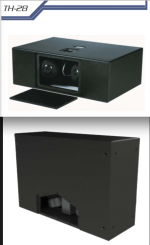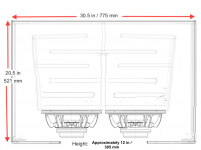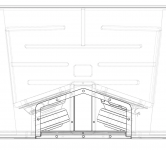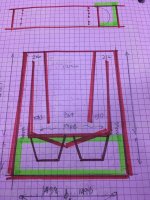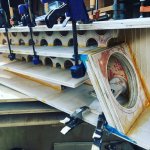The Danleysound TH28 is a 2x8" TH with an Fb somewhere in the low 40s. The dimensions are of interest though. Almost a perfect fit for my car's small trunk. I'm curious if it might be possible to DIY one that's slightly larger to fit two 10s that has an Fb at or below 40 Hz?
Yes making a tapped horn for a car is possible. I do however think that a simple vented box is better for a car. It can be smaller for the same output, at the cost of requiring a more amplifier power.
The Danleysound TH28 is tuned at approximately 45 Hz (and 100 Hz), judging from the impedance plot in the spec sheet. That seems a bit high for a car subwoofer to me.
The Danleysound TH28 is tuned at approximately 45 Hz (and 100 Hz), judging from the impedance plot in the spec sheet. That seems a bit high for a car subwoofer to me.
It's not for only car audio duty. It's also for a small DJ system that can be transported in, and powered by, the car. The intent here is to get the most efficient use out of subwoofer drivers in a box that can fit in the trunk.
I know that the TH28 is tuned a bit high, hence my idea of making the box a bit larger to see if that can move the Fb down to around 40 Hz.
I know that the TH28 is tuned a bit high, hence my idea of making the box a bit larger to see if that can move the Fb down to around 40 Hz.
Brian,I know that the TH28 is tuned a bit high, hence my idea of making the box a bit larger to see if that can move the Fb down to around 40 Hz.
Your new avatar creeps me out, brings back memories of wrapping Faygo soda pop drenched sticky cables after the Insane Clown Posse did their thing 😱
To get the Fb down to 40 Hz in the DSL TH-28 form factor would require one more fold than the original, the attachment shows an example with the extra path length fit into the same size, other than the extra height required for the 10" drivers, which are shown slightly undersized- my scaling is off...
The extra path length may reduce the usable upper bandwidth a bit, though that could be "cheated" making a "<>" shaped exit. I have not shown the exit shape in the 2x10" attachment.
The TH-28 has two user configurable exit choices, I'd suspect the 20" tall set up would have a bit more forward gain than the "stair step" choice, though DSL did not indicate which configuration was used in the 8/11/2005 measurement.
Art
Attachments
Last edited:
Thanks for that info, Art. The "redesign" I'm thinking of is actually widening the box, which should increase the path length a bit, and the narrow paths might actually be a better match for "car audio" type subwoofers with their smaller box requirements. The TH pictures seem to show the drivers mounted at an angle, rather than on a flat baffle board - is the diagram a simplified diagram of the actual layout? I suspect that it's not going to make that much of a difference anyway.
Looks like I'm going to be pretty busy over the next few days, but as soon as I have a chance, I'm going to try to BOXPLAN the layout.
Thanks again!
Looks like I'm going to be pretty busy over the next few days, but as soon as I have a chance, I'm going to try to BOXPLAN the layout.
Thanks again!
I can’t ever decide whether to just go with this Driver entry as it promotes the more beneficial fold affectively. Or the fact that it requires a tilted baffle half the time to fit The driver and CSA found in HR. Either way it helps promote the slightly longer length that you need on the initial length from the closed end.
but that’s where things start to look funny if you look at what else is going on?
~ 28.8 hz is (104.76cm entry) 300cm in standard form without intentional taper/reduction to lower that. And coincidentally a 30° baffle tilt is 52.38 radians, as 12 on 6.9375 as a slope (1/2 the 104.76 in radians as 60 degrees) . I’m pretty sure it’s supposed to work out like that, but this is weird how the numbers hook up? And :
300x 0.3492 is 104.76. And 5.23809 (300 degrees as radians) plus 1.047619 is 6.2857142?
I hate math …
But can anyone figure this out ? It goes on to create an equation for many things including offset driver entry points in transmission lines based on the circle. I just stumbled on this part because it’s actually jumping the dimensions in math and function? You could see it in your freq response in greater detail with appropriate CSA(s).
Where it really shines is actually in a car because there’s less junk coming out the exit if it’s folded and broken up appropriately for its fundamental and it’s 3×1/4 harmonic but that rear chamber area also contributes it kept large and brief as pictured to number 5×1/4. And you’re sitting on a very nice enclosureAnd hopefully a lot less nonsense as high frequency material all over the place in that boundary condition of the vehicle where things get really ugly really quick. It seems to help substantially but that’s not fair to claim….imo.
Both well damped and sized for the driver but also an enormous band with up and down that’s clean. It hasn’t been chopped up with excessive folding. And the car audio guys just make snakes and random parts of a Labrinth they don’t even break it up evenly as ART did so nicely . Big vented reflexes?
Here’s more math (haahaaa!5.23809 minus 1.0476 is 4.190476 for qw .
the V of a sphere equation of radius is 1.0? 4/3 pi r ^3 is 1.333333(22/7) (1)^3.
so if r is 1, then V is 4.190476(240 degrees)
And if r is 0.5, then V is 0.5238(30 degrees)
if you plug those into circumference:
They’re very useful in the compound the pipes or tapped entries. For whatever reason the descriptions of a sphere in radians or degrees as centimeters of circumference is extremely effective in all of quarter wave. End it breaks up into PHI as 15* parts (0.2618radians or CM of circ). 105 cm (or degrees) is seven of those and the remainder as 195 cm to the 300 is 13.
And 300÷105 is 0.35 (0.349 per Martin King). 20 /7is 2.857142 Which is the inverse (1/x) of 0.35.
0.5238 and 1.0476 are the sides of a rectangle that totals 3.142857 in circumference.? And that rectangle has a Hypotenuse 1.0395. That’s the same exact measurement as the inside of the kings chamber in the Egyptian pyramids precisely.
Tom Danley went to the same location that I’m referring to in the same pyramid no doubt? I haven’t been, but I have the blueprint thanks to a guy who is using the same numbers to write crypto patterns and for acoustical devices in the medical field? Robert E. Grant. A published author of ‘Philo math’. A strange book with interesting ideas . However it seems he has been doing the same thing I’ve been doing with these numbers he’s just over complicating it with no connection or ability to see things like the luxury in horn response To filter them with?
If anyone talks to talk to Mr Danley, you coujd ask him about the speed of light in radians and it’s affective function in quarter wave alignments?
you should see what these numbers do in other things! They perfectly align both sides in a compound pipe or a series tuned like a Roar. Including the details of driver entry and exit etc..
If there really is something to the pyramid? even if they don’t ever discover it in our lifetimes? if ever , we can already put it into use speakers and observe some sort of strange coincidence. It’s not a coincidence however. If You measure the side angle of any diagonal on the exterior alone (51.84*) can you put that angle as - 51.84 degrees Celsius into a pipe resonance calculator. You get the speed of light as the speed of sound or 363 m/sec as the + 51.84 degrees, Celcius. 🧐🧐
And look at the centimeter . Its 1/x (.254).
.254 minus 0.004 that each interval is exactly the same as Bodes law. It’s also exact same thing that happens at all frequencies canceled out after 860 in a compound pipe they each lose 4 Hz in sequence. Meaning 864(what is the number of seconds in a day and the diameter of the sun in miles) is reduced to 860 and 1728 is reduced to 1720 and so on 96 times to 19780hz at -4, which is 24 intervals . Or 864/360 .
but that’s where things start to look funny if you look at what else is going on?
~ 28.8 hz is (104.76cm entry) 300cm in standard form without intentional taper/reduction to lower that. And coincidentally a 30° baffle tilt is 52.38 radians, as 12 on 6.9375 as a slope (1/2 the 104.76 in radians as 60 degrees) . I’m pretty sure it’s supposed to work out like that, but this is weird how the numbers hook up? And :
300x 0.3492 is 104.76. And 5.23809 (300 degrees as radians) plus 1.047619 is 6.2857142?
I hate math …
But can anyone figure this out ? It goes on to create an equation for many things including offset driver entry points in transmission lines based on the circle. I just stumbled on this part because it’s actually jumping the dimensions in math and function? You could see it in your freq response in greater detail with appropriate CSA(s).
Where it really shines is actually in a car because there’s less junk coming out the exit if it’s folded and broken up appropriately for its fundamental and it’s 3×1/4 harmonic but that rear chamber area also contributes it kept large and brief as pictured to number 5×1/4. And you’re sitting on a very nice enclosureAnd hopefully a lot less nonsense as high frequency material all over the place in that boundary condition of the vehicle where things get really ugly really quick. It seems to help substantially but that’s not fair to claim….imo.
Both well damped and sized for the driver but also an enormous band with up and down that’s clean. It hasn’t been chopped up with excessive folding. And the car audio guys just make snakes and random parts of a Labrinth they don’t even break it up evenly as ART did so nicely . Big vented reflexes?
Here’s more math (haahaaa!5.23809 minus 1.0476 is 4.190476 for qw .
the V of a sphere equation of radius is 1.0? 4/3 pi r ^3 is 1.333333(22/7) (1)^3.
so if r is 1, then V is 4.190476(240 degrees)
And if r is 0.5, then V is 0.5238(30 degrees)
if you plug those into circumference:
They’re very useful in the compound the pipes or tapped entries. For whatever reason the descriptions of a sphere in radians or degrees as centimeters of circumference is extremely effective in all of quarter wave. End it breaks up into PHI as 15* parts (0.2618radians or CM of circ). 105 cm (or degrees) is seven of those and the remainder as 195 cm to the 300 is 13.
And 300÷105 is 0.35 (0.349 per Martin King). 20 /7is 2.857142 Which is the inverse (1/x) of 0.35.
0.5238 and 1.0476 are the sides of a rectangle that totals 3.142857 in circumference.? And that rectangle has a Hypotenuse 1.0395. That’s the same exact measurement as the inside of the kings chamber in the Egyptian pyramids precisely.
Tom Danley went to the same location that I’m referring to in the same pyramid no doubt? I haven’t been, but I have the blueprint thanks to a guy who is using the same numbers to write crypto patterns and for acoustical devices in the medical field? Robert E. Grant. A published author of ‘Philo math’. A strange book with interesting ideas . However it seems he has been doing the same thing I’ve been doing with these numbers he’s just over complicating it with no connection or ability to see things like the luxury in horn response To filter them with?
If anyone talks to talk to Mr Danley, you coujd ask him about the speed of light in radians and it’s affective function in quarter wave alignments?
you should see what these numbers do in other things! They perfectly align both sides in a compound pipe or a series tuned like a Roar. Including the details of driver entry and exit etc..
If there really is something to the pyramid? even if they don’t ever discover it in our lifetimes? if ever , we can already put it into use speakers and observe some sort of strange coincidence. It’s not a coincidence however. If You measure the side angle of any diagonal on the exterior alone (51.84*) can you put that angle as - 51.84 degrees Celsius into a pipe resonance calculator. You get the speed of light as the speed of sound or 363 m/sec as the + 51.84 degrees, Celcius. 🧐🧐
And look at the centimeter . Its 1/x (.254).
.254 minus 0.004 that each interval is exactly the same as Bodes law. It’s also exact same thing that happens at all frequencies canceled out after 860 in a compound pipe they each lose 4 Hz in sequence. Meaning 864(what is the number of seconds in a day and the diameter of the sun in miles) is reduced to 860 and 1728 is reduced to 1720 and so on 96 times to 19780hz at -4, which is 24 intervals . Or 864/360 .
Attachments
- Home
- Loudspeakers
- Subwoofers
- Danleysound TH28 -> 2 x 10" TH for car audio use?
